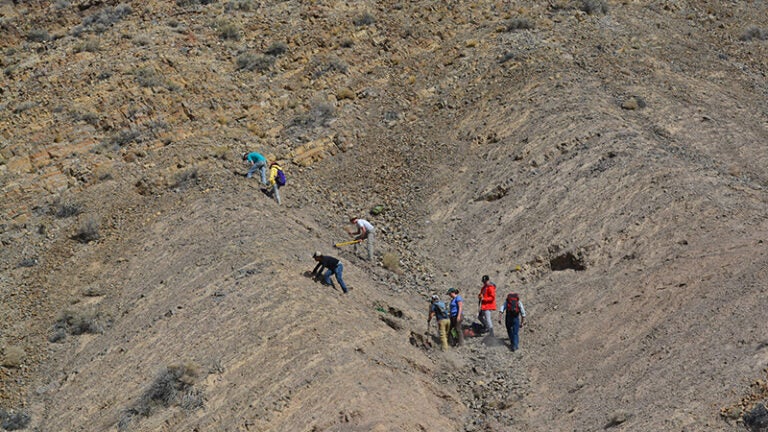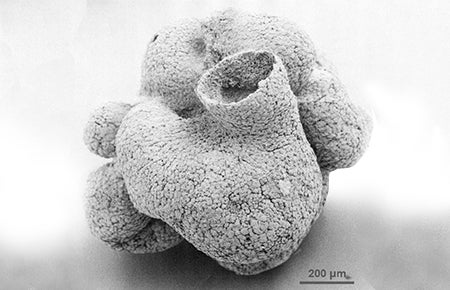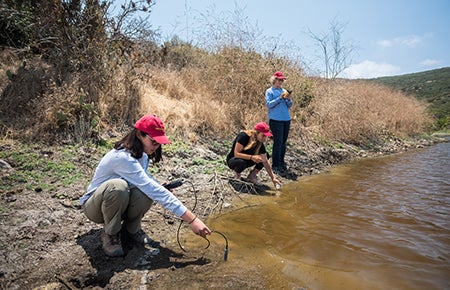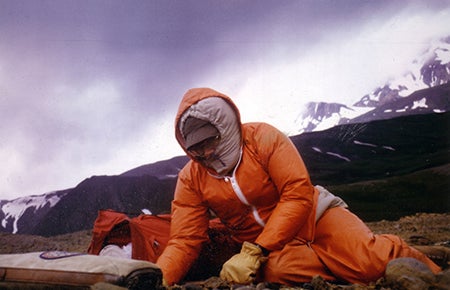
What Lies Beneath
There’s a philosophical dimension to looking at the very distant past. It gives us an opportunity to reevaluate our relative significance in the grand scheme of life. In terms of the Earth’s entire history, humans have inhabited this planet for barely a moment. The vast stretches of time that preceded us were filled by other forms of life, and their existence — and the clues their remnants hold — offer valuable insight into our current circumstances.
For USC Dornsife scientist David Bottjer, who, as a young student, was as much interested in history as natural sciences, the clues within the fossil record can provide a foundational lesson on how we came to be.
“[Paleobiology] is not learning about the British Empire, but in a lot of ways it’s the same kind of thing,” he said. “Why did life succeed or fail? How did it evolve and change? Just like a lot of the questions you might ask about human history.”
The answers may foretell the many possible futures that await us, and the impact our choices today will have on each.
But there’s more to it than that. Beyond the past’s potential to inform us of what may lie ahead, Lynn Dodd of USC Dornsife’s archaeology program sees another kind of value in studying remnants of history — an intrinsic significance that speaks to the heart of humanity.
“If we live without any sense of our past — the richness and diversity and possibility of how we lived — we’re impoverished,” she said. “We’re adding to the richness in our own mental treasure chests by investigating and trying to answer questions about the past and the people who lived in it.”
In the blink of an eye
“Ancient” means something different to everyone. For some, it’s anything pre-internet. For others, it conjures Roman aqueducts or the pyramids.
When Bottjer says “ancient,” he’s talking 600 million years ago.
As a paleobiologist — the newer, more interdisciplinary version of a paleontologist — and professor of Earth sciences, biological sciences and environmental studies, he knows it can be difficult for people to get their heads around time on this scale.
“The Earth is 4.5 billion years old, but life has been on Earth for about three and a half billion years,” he said. “So 600 million is actually not that far back.”
It was around this time, he said, that the first animals — simple ones like sponges — began to evolve.

This ancient Doushantuo sponge, only half a millimeter across, is among the fossils studied by David Bottjer at the Weng’an site in China. After the organism died, phosphate replaced its tissues cell by cell, creating a perfectly preserved relic. At 600 million years old, it may be the world’s oldest sponge.
A record of fossilized life forms spanning several billion years — a mind-boggling timeframe referred to as “geological” or “deep” time — lies buried beneath our feet within layers of sedimentary rock. Bottjer likens these layers to the teetering stacks of paper on his office desk, explaining that within them are clues about what Earth’s environment was like in the past, and how conditions have changed over millions of years — the blink of an eye in geological time.
Bottjer has been doing paleobiology research in China for nearly 20 years. He works with scientists from the Nanjing Institute of Geology and Paleontology, part of the Chinese Academy of Sciences, and elsewhere at the Weng’an site in the Guizhou province of southern China. They study some of the oldest known animal fossils on Earth.
“If you want to know about how animals evolved on Earth,” he said, “this site is the most important one we know of.”
Two years ago, Bottjer and international colleagues unearthed a tiny sponge fossil that was determined to be 600 million years old. Roughly the size of a grain of sand, the fossil proved that the animal’s evolution began millions of years earlier than previously thought, imparting an ancient lesson that sheds new light for today’s scientists on how evolution takes place in organisms.
‘The experiment has been run’
Over the course of its long history, Earth has experienced a number of dramatic climatic shifts. Their impact on the evolution of plants and animals can be traced through the fossil record. Different climates gave rise to different environments and living organisms. However, periods of rapid warming due to natural phenomena such as intense volcanism sometimes resulted in mass extinctions. A growing body of scientific evidence suggests that we are headed toward another mass extinction, this one caused by human activity, including human-induced climate change.
Bottjer and his USC colleagues, thanks to a $1 million National Science Foundation grant, have spent the last few years looking at a mass extinction that took place 250 million years ago, on the border of the Triassic and Jurassic periods. The supercontinent Pangea was breaking apart along tectonic lines, resulting in a time of intense volcanic activity. This led to a dramatic increase in atmospheric greenhouse gases and a corresponding warming effect.
“We want to see if [the Triassic-Jurassic extinction] can help us learn about what’s happening today, because the experiment has already been run.”USC Dornsife faculty and graduate researchers have been studying this period at sites high in the Andes Mountains in Peru. Within the layers of sedimentary rock in that region, limestones contain fossils whose age can be determined by measuring radioactive decay in adjacent volcanic ash beds. This allows scientists to observe the impact of the warming on ancient ecology, portending possible challenges ahead for humanity.
Researchers are interested in the Triassic-Jurassic extinction in particular because the rapid climate change and dramatic rise of carbon dioxide levels in the atmosphere during that period are quite similar to what is happening today. Their research addresses pressing questions about how climate change might affect our planet in the very near future.
“Right now is the fastest the temperature has ever increased in geological time,” Bottjer said. “We want to see if [the Triassic-Jurassic extinction] can help us learn about what’s happening today, because the experiment has already been run. So, we’d like to think that we can at least provide some general predictions about where things might be going.”
Outpacing evolution
In that ancient experiment, Earth got hot quickly — over the course of less than 10,000 years — killing off about half of the Earth’s species. Among the first to die were the ocean’s coral reefs — often thought of as the canary in the coal mine due to their sensitivity to climate shifts — which all but disappeared for roughly 400,000 years. Eventually the Earth cooled down and animals began to repopulate, though in this context, “eventually” means 700,000 years later.
Now history is repeating itself. The Great Barrier Reef off the coast of Australia, the largest living organism on Earth, has been ravaged by rising ocean temperatures in recent years. Normally hubs of biodiversity, these coral reefs have experienced unprecedented episodes of mass bleaching for the past two consecutive years.
Ideally, changes in climate occur at a rate that allows life on Earth to adapt to the changing conditions.
“We know that when climate change goes really fast, evolution can’t keep up,” Bottjer said. “If it goes slowly, evolution is a process that can make adjustments, and animals and plants can sort of manage and not go extinct. But if it goes faster than evolution can chase it, that leads to a mass extinction.”
Obviously we’re powerless to prevent rapid climate change caused by processes such as volcanic eruptions. But, Bottjer said, since humans are expediting the process of climate change, and given the serious consequences, we should acknowledge that in this case we can potentially do something about it.
This is part of what motivates Bottjer in his research. And as a professor, he is sharing this important motivation with the next generation.
“Maybe we won’t get ourselves into such a jam again if we study how this happened in the past,” he said. “This stuff will be the biggest challenge for the lives of the students we are currently educating.”
Taking a Long View

Lynn Dodd, right, and her students map a recently reappeared catch basin on Catalina Island this past summer by recording GPS data and collecting hydrology measurements of the water.
Along with the histories of ancient animals on Earth, early humans and the ways of life they adopted thousands of years ago also offer us wisdom today.
The USC Archaeology Research Center houses an impressive collection of artifacts, and offers opportunities for students to get firsthand fieldwork and research experience in Los Angeles and other parts of the world.
“Looking to the past, we can learn some very interesting things that give us a long-term perspective on problems we continue to face,” said Dodd, associate professor of the practice of religion and curator of the collection. “As an archaeologist, I tend to look at things with a long view, and that’s 1,000 or 10,000 years in the past. But it’s also 1,000 or 10,000 years into the future.”
Dodd directs the interdisciplinary archaeology program at USC Dornsife. She is fascinated by holy land, sacred territory and the persistent question of why the past matters today.
Right now, the focus of her archaeology research is Santa Catalina Island, located 22 miles off the Southern California coast. The land is sacred territory for the Tongva, or Gabrielino, Native Americans, who have a history there stretching back at least 8,000 years and who today often refer to the location by its traditional name: Pimu or Pimunga.
“Catalina is compelling because it’s a place where we can see the early peopling of this continent and the ways that inhabitants adapted to a coastal lifestyle in the region,” Dodd said. “We want to know, how did they live in a way that enabled them to sustain that way of life for thousands upon thousands of years? Are there lessons we can learn from that?”
Changing the course of history
Dodd and her students are studying how humans interacted with the natural ecosystem when they first came to the island. She’s also intrigued by how the arrival of other groups of humans can affect, or even erase, ecosystems and ways of life that had persisted for millennia.
Their archaeology work on Catalina helps bring to life a portrait of how people lived in that environment for generations in a largely sustainable way. According to Dodd, everything changed in the 17th century, when Spanish settlers arrived on Catalina and the Channel Islands to the north. They set the environment on a new course toward population growth and introduced new, invasive species. Domesticated animals like cattle, sheep and pigs grazed the native plants. Ranching and fishing activities eventually led to the extinction of certain native species.
“Looking to the past, we can learn some very interesting things that give us a long-term perspective on problems we continue to face.”And yet, she points out, this is not an irreversible process. Most of the Channel Islands are now national park land, managed by federal agencies and conservation groups. In 1975, Philip Wrigley and his sister Dorothy Wrigley Offield donated 42,000 acres to the Catalina Island Conservancy to promote conservation over development and to house USC Dornsife’s Wrigley Marine Science Center on the island. In recent decades, there has been significant progress in restoring native ecosystems.
“When [grazing animals] were removed from the Channel Islands, the denuded landscape started to rebound,” Dodd said. “And if you go to Catalina, you can see that playing out now — native plants being allowed to flourish again — and that’s a really exciting and informative result.”
Into the blue
In trying to understand the island’s human history, Dodd and several student researchers are looking at the key resource required to sustain life: water. When people first arrived on Catalina Island at least eight millennia ago, the sea level was several hundred feet lower than it is today.
Historically, Catalina had more freshwater sources than it currently does, because some of them are now submerged beneath the sea. The apparent dearth of water today is proving a challenge to present-day island residents and businesses, and overcoming that challenge is the focus of significant study and conservation efforts at the USC Wrigley Institute.
Dodd and the student researchers, for their part, are creating maps that show where water has flowed in the past. An interdisciplinary team can gather clues by digging soil core samples in ancient lakes and beneath old and existing streams. They use hydrological measurements and GPS data, and look for evidence of water-loving plants like cattails. They also note where freshwater flows out into the ocean.
Seeking adaptive solutions
It’s worth noting that those sea levels are still rising — and quickly — as a result of climate change.
A lot of creative thinking is required to tackle this problem. Having a good understanding of how past humans have successfully adapted — what kinds of systems and thinking motivated and sustained them over thousands of years — should not be overlooked.
For example, the Tongva relied upon a diverse resource base in addition to cooperation and alliances between different social groups, which created other options to fall back on in times of drought or disease.
“These are lessons that are extremely important to teach people and give them an opportunity to think about,” Dodd emphasized.
She acknowledges that there is not a direct analogue between a highly industrialized, urbanized society and the way of life of a band of hunter-gatherers. Nonetheless, there are still valuable lessons we can learn from people in the past.
“[This research] highlights the concept that we as a community have the capacity to live in a sustainable way, much more than we do now,” she said. “And also, that we can effect change to incorporate those principles and ways of thinking that will benefit us not only now, but for generations into the future.”
From Southern California to the Arctic

Geologist Lou Marincovich spent his career researching fossils in the wilds of Alaska. He recently documented his experiences in a memoir, True North: Hunting Fossils Under the Midnight Sun (Bering Press, 2017).
In addition to fossil discoveries made on land, the planet’s oceans also have a rich past to reveal.
Long before earning a Ph.D. in geology in 1973, USC Dornsife alumnus Lou Marincovich remembers receiving a children’s book from his mother called All About Dinosaurs that ignited his fascination with fossils. Eventually, though, growing up next to the ocean in San Pedro, Calif., caused his focus to shift.
“My boyish enthusiasm switched from dinosaurs to seashells over time because I could actually collect fossilized and modern shells in my neighborhood,” Marincovich said.
His abiding interest in ancient life led him to attend graduate school in the late 1960s. To earn money for tuition, he spent eight months working on offshore oil drilling platforms in Alaska and was captivated by the far north. As a newly minted Ph.D., he got a job at the oil company Texaco and was dispatched to a tent camp in northern Alaska.
“We camped out for months in absolute wilderness while I looked for fossils and collected rocks for oil company purposes,” Marincovich said. “I was in hog heaven; I was finally studying fossils in the wilderness, which I had dreamed of as a boy.”
It was the beginning of a fruitful career in paleontology that took him from Alaska to Siberia and the Canadian Arctic Archipelago, near the North Pole. After his stint with Texaco, his research for the U.S. Geological Survey and the California Academy of Sciences documented the changing climate of the Arctic over 60 million years, based on the migration patterns of mollusks between Asia and North America.
Tropical paradise in the Arctic
Marincovich specializes in the Cenozoic Era, which began about 65 million years ago, following the demise of the dinosaurs.
“At that time you started seeing modern types of animals proliferate, such as mammals and seashells, that look like the ones you could find on the beach of Santa Monica instead of weird-looking things that look really ancient,” he said.
“My boyish enthusiasm switched from dinosaurs to seashells over time because I could actually collect fossilized and modern shells in my neighborhood.”Marincovich’s research examines how today’s seashell faunas have evolved over millions of years, which also helps scientists interpret historical climate shifts. Studying Arctic fossils has helped him identify notable cycles of warming and cooling in the far north.
“At times in the past, the seas in southern Alaska that are frigid today were subtropical,” Marincovich said. “[Through the fossil record] you can see the shells migrating up the west coast of North America, and also coming over from Japan and Siberia, and meeting in Alaska.”
Periods of warmer climate in the Arctic region are corroborated by terrestrial fossil evidence.
“Fifty million years ago there were a lot of animals and plants living on land that couldn’t have lived there if it was the frozen waste that it is today,” he said. “Fossils provide the only record of what really happens when nature shifts one way or the other.”
Analyzing oceanic fossils and tracing temperature shifts in the environment allow scientists to map climate conditions for that part of the world, which they can then correlate with lower-latitude places like California, Mexico or Japan. In this way, scientists like Marincovich are helping to put the puzzle pieces of climate history in place.
Marincovich’s research also helped him determine the age of the Bering Strait, the last of the Earth’s seaways to be definitively dated. Scientists had grappled with the question for a century. He fortuitously discovered an Alaskan fossil clam, a specimen of the genus Astarte. The age and the location of the fossil helped him solve the mystery: The strait is 5.5 million years old.
The discovery allows evolutionary biologists to calculate rates of evolution for mammals and plants on both sides of the strait since the populations were separated into Asia and North America. For Marincovich, it’s just another example of the wisdom we can glean from the Earth’s past — and the implications for its future — if we listen more closely to the soothsayers right beneath our feet.
“We have to piece together the history,” he said. “The shells were mortal, but their value as messengers of the past is immortal.”
Read more stories from USC Dornsife Magazine’s Fall 2017-Winter 2018 issue >>